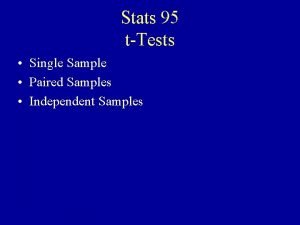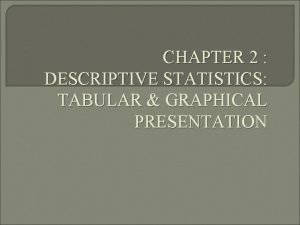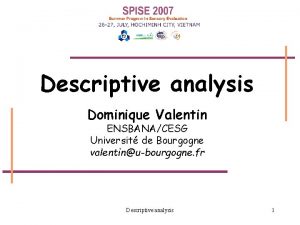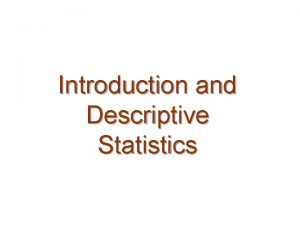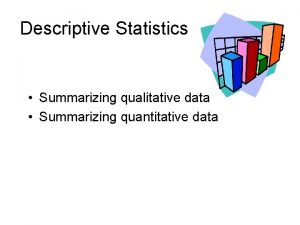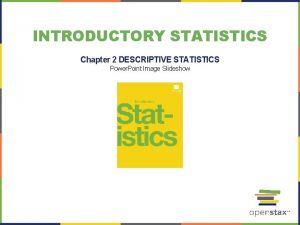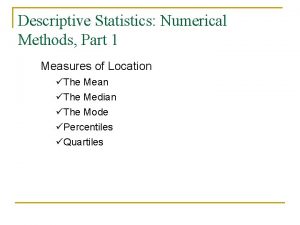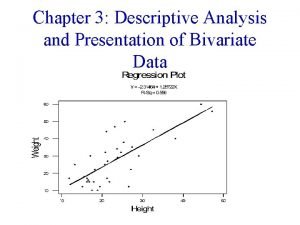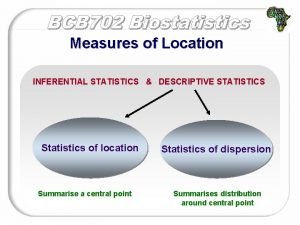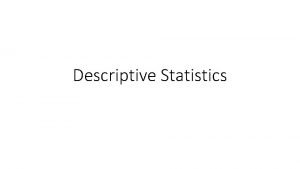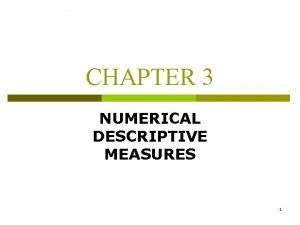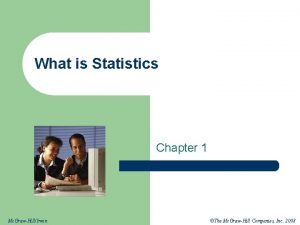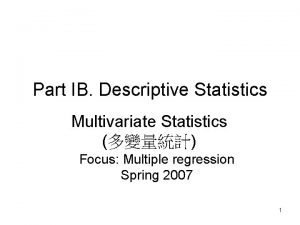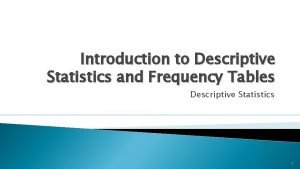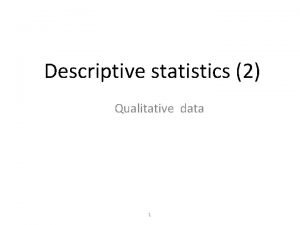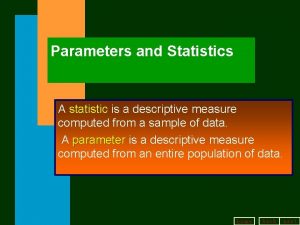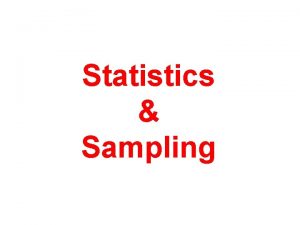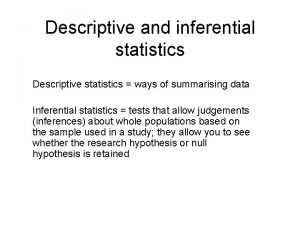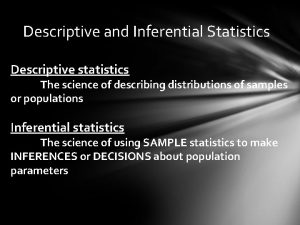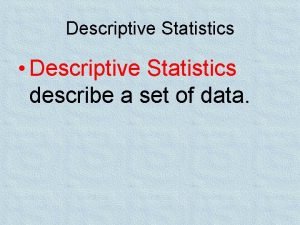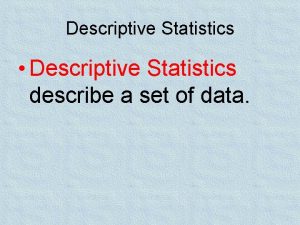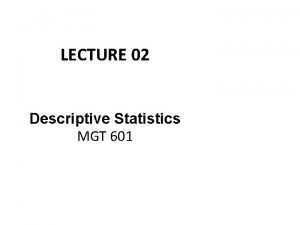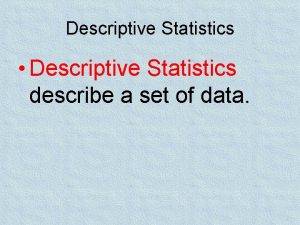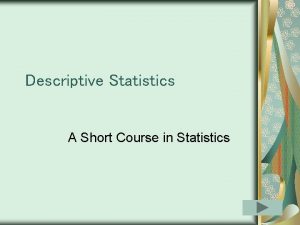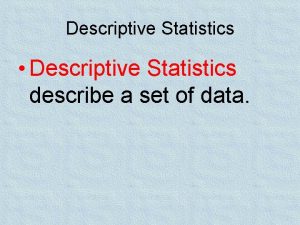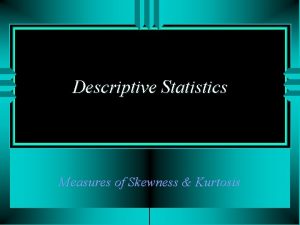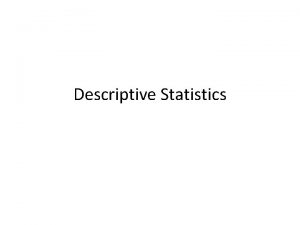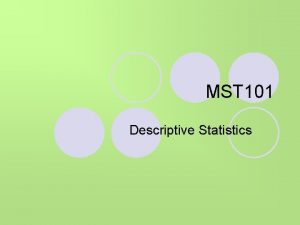Parameters and Statistics A statistic is a descriptive























- Slides: 23

Parameters and Statistics A statistic is a descriptive measure computed from a sample of data. A parameter is a descriptive measure computed from an entire population of data. home back next

Measures of Central Tendency - Arithmetic Mean - The arithmetic mean of a set of data is the sum of the data values divided by the number of observations. home back next

Sample Mean If the data set is from a sample, then the sample mean, , is: home back next

Population Mean If the data set is from a population, then the population mean, , is: home back next

Measures of Central Tendency - Median - An ordered array is an arrangement of data in either ascending or descending order. Once the data are arranged in ascending order, the median is the value such that 50% of the observations are smaller and 50% of the observations are larger. home back next

Measures of Central Tendency - Median - If the sample size n is an odd number, the median, Xm, is the middle observation. If the sample size n is an even number, the median, median Xm, is the average of the two middle observations. The median will be located in the 0. 50(n+1)th ordered position home back next

Measures of Central Tendency - Mode - The mode, if one exists, is the most frequently occurring observation in the sample or population. home back next

Shape of the Distribution The shape of the distribution is said to be symmetric if the observations are balanced, or evenly distributed, about the mean. In a symmetric distribution the mean and median are equal. home back next

Shape of the Distribution A distribution is skewed if the observations are not symmetrically distributed above and below the mean. A positively skewed (or skewed to the right) distribution has a tail that extends to the right in the direction of positive values. A negatively skewed (or skewed to the left) distribution has a tail that extends to the left in the direction of negative values. home back next

Shapes of the Distribution home back next

Measures of Variability - The Range - The range is in a set of data is the difference between the largest and smallest observations home back next

Measures of Variability - Sample Variance - The sample variance, s 2, is the sum of the squared differences between each observation and the sample mean divided by the sample size minus 1. home back next

Measures of Variability - Short-cut Formulas for s 2 Short-cut formulas for the sample variance, s 2, are: home back next

Measures of Variability - Population Variance The population variance, 2, is the sum of the squared differences between each observation and the population mean divided by the population size, N. home back next

Measures of Variability - Sample Standard Deviation - The sample standard deviation, s, is the positive square root of the variance, and is defined as: home back next

Measures of Variability - Population Standard Deviation- The population standard deviation, , is home back next

The Empirical Rule (the 68%, 95%, or almost all rule) • • • For a set of data with a mound-shaped histogram, the Empirical Rule is: approximately 68% of the observations are contained with a distance of one standard deviation around the mean; 1 approximately 95% of the observations are contained with a distance of 2 standard deviations around the mean; 2 almost all of the observations are contained with a distance of three standard deviation around the mean; 3 home back next

Coefficient of Variation The Coefficient of Variation, CV, is a measure of relative dispersion that expresses the standard deviation as a percentage of the mean (provided the mean is positive). The sample coefficient of variation is home back next

Coefficient of Variation The population coefficient of variation is home back next

Percentiles and Quartiles Data must first be in ascending order. Percentiles separate large ordered data sets into 100 ths. The Pth percentile is a number such that P percent of all the observations are at or below that number. Quartiles are descriptive measures that separate large ordered data sets into four quarters. home back next

Percentiles and Quartiles The first quartile, Q 1, is another name for the 25 th percentile The first quartile divides the ordered data such that 25% of the observations are at or below this value. Q 1 is located in the. 25(n+1)st position when the data is in ascending order. That is, home back next

Percentiles and Quartiles The third quartile, Q 3, is another name for the 75 th percentile The first quartile divides the ordered data such that 75% of the observations are at or below this value. Q 3 is located in the. 75(n+1)st position when the data is in ascending order. That is, home back next

Interquartile Range The Interquartile Range (IQR) measures the spread in the middle 50% of the data; that is the difference between the observations at the 25 th and the 75 th percentiles: home back next
 Dependent ttest
Dependent ttest What are parameters in statistics
What are parameters in statistics Inferential statistics allow us to
Inferential statistics allow us to Tabular presentation of qualitative data
Tabular presentation of qualitative data Descriptive statistics in business
Descriptive statistics in business Example of descriptive statistics
Example of descriptive statistics Descriptive statistics ap psychology
Descriptive statistics ap psychology Introduction to descriptive statistics
Introduction to descriptive statistics Summarizing qualitative data
Summarizing qualitative data Chapter 2 descriptive statistics answer key
Chapter 2 descriptive statistics answer key Numerical descriptive statistics
Numerical descriptive statistics Descriptive statistics numerical measures
Descriptive statistics numerical measures Bivariate descriptive statistics
Bivariate descriptive statistics Our location
Our location Kinds of descriptive statistics
Kinds of descriptive statistics Jack in box
Jack in box Variance standard deviation formula
Variance standard deviation formula Inferential statistics definition
Inferential statistics definition Data pensylvania1
Data pensylvania1 Definition of descriptive statistics
Definition of descriptive statistics Multivariate descriptive statistics
Multivariate descriptive statistics Categorical frequency distribution example
Categorical frequency distribution example Types of statistics
Types of statistics Descriptive statistics classification
Descriptive statistics classification
